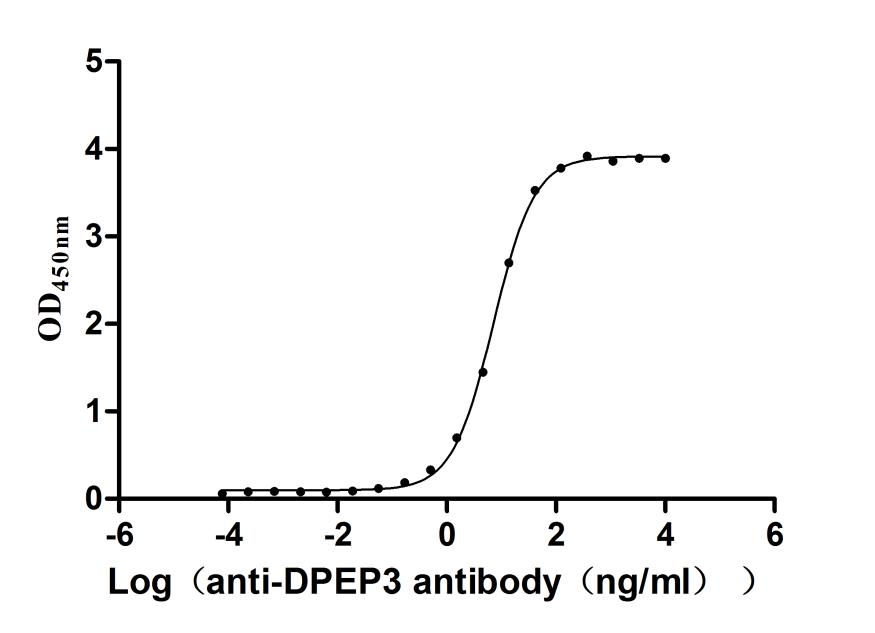Recombinant Human Ankyrin repeat domain-containing protein 11 (ANKRD11), partial
-
中文名稱:Recombinant Human Ankyrin repeat domain-containing protein 11(ANKRD11) ,partial,Yeast
-
貨號(hào):CSB-YP757769HU
-
規(guī)格:
-
來(lái)源:Yeast
-
其他:
-
中文名稱:Recombinant Human Ankyrin repeat domain-containing protein 11(ANKRD11) ,partial,Yeast
-
貨號(hào):CSB-EP757769HU
-
規(guī)格:
-
來(lái)源:E.coli
-
其他:
-
中文名稱:Recombinant Human Ankyrin repeat domain-containing protein 11(ANKRD11) ,partial,Yeast
-
貨號(hào):CSB-EP757769HU-B
-
規(guī)格:
-
來(lái)源:E.coli
-
共軛:Avi-tag Biotinylated
E. coli biotin ligase (BirA) is highly specific in covalently attaching biotin to the 15 amino acid AviTag peptide. This recombinant protein was biotinylated in vivo by AviTag-BirA technology, which method is BriA catalyzes amide linkage between the biotin and the specific lysine of the AviTag.
-
其他:
-
中文名稱:Recombinant Human Ankyrin repeat domain-containing protein 11(ANKRD11) ,partial,Yeast
-
貨號(hào):CSB-BP757769HU
-
規(guī)格:
-
來(lái)源:Baculovirus
-
其他:
-
中文名稱:Recombinant Human Ankyrin repeat domain-containing protein 11(ANKRD11) ,partial,Yeast
-
貨號(hào):CSB-MP757769HU
-
規(guī)格:
-
來(lái)源:Mammalian cell
-
其他:
產(chǎn)品詳情
-
純度:>85% (SDS-PAGE)
-
基因名:ANKRD11
-
Uniprot No.:
-
別名:ANKRD11; ANCO1Ankyrin repeat domain-containing protein 11; Ankyrin repeat-containing cofactor 1
-
種屬:Homo sapiens (Human)
-
蛋白長(zhǎng)度:Partial
-
蛋白標(biāo)簽:Tag?type?will?be?determined?during?the?manufacturing?process.
The tag type will be determined during production process. If you have specified tag type, please tell us and we will develop the specified tag preferentially. -
產(chǎn)品提供形式:Lyophilized powder
Note: We will preferentially ship the format that we have in stock, however, if you have any special requirement for the format, please remark your requirement when placing the order, we will prepare according to your demand. -
復(fù)溶:We recommend that this vial be briefly centrifuged prior to opening to bring the contents to the bottom. Please reconstitute protein in deionized sterile water to a concentration of 0.1-1.0 mg/mL.We recommend to add 5-50% of glycerol (final concentration) and aliquot for long-term storage at -20℃/-80℃. Our default final concentration of glycerol is 50%. Customers could use it as reference.
-
儲(chǔ)存條件:Store at -20°C/-80°C upon receipt, aliquoting is necessary for mutiple use. Avoid repeated freeze-thaw cycles.
-
保質(zhì)期:The shelf life is related to many factors, storage state, buffer ingredients, storage temperature and the stability of the protein itself.
Generally, the shelf life of liquid form is 6 months at -20°C/-80°C. The shelf life of lyophilized form is 12 months at -20°C/-80°C. -
貨期:Delivery time may differ from different purchasing way or location, please kindly consult your local distributors for specific delivery time.Note: All of our proteins are default shipped with normal blue ice packs, if you request to ship with dry ice, please communicate with us in advance and extra fees will be charged.
-
注意事項(xiàng):Repeated freezing and thawing is not recommended. Store working aliquots at 4°C for up to one week.
-
Datasheet :Please contact us to get it.
相關(guān)產(chǎn)品
靶點(diǎn)詳情
-
功能:Chromatin regulator which modulates histone acetylation and gene expression in neural precursor cells. May recruit histone deacetylases (HDACs) to the p160 coactivators/nuclear receptor complex to inhibit ligand-dependent transactivation. Has a role in proliferation and development of cortical neural precursors. May also regulate bone homeostasis.
-
基因功能參考文獻(xiàn):
- ANKRD11 variants cause variable clinical features associated with KBG syndrome and Coffin-Siris-like syndrome. PMID: 28250421
- exome sequencing identified a novel de novo heterozygous single base pair duplication (c.6015dupA) in ANKRD11, which is predicted to lead to a premature stop codon and loss of function in ANKRD11, thereby implicating it as contributing to the molecular diagnosis of KBG syndrome. PMID: 27900361
- Here we report a large series of 39 patients with KBG syndrome; these patients harbored ANKRD11 mutations (20 cases) or deletions (19 cases). All the mutations were found by targeted molecular analysis on patients with clinical features suggestive of KBG. PMID: 27605097
- Twelve novel cases of haploinsufficiency for ANKRD11-flanking genes make the difference between KBG and 16q24.3 microdeletion syndromes. PMID: 28422132
- These findings point out the importance of screening ANKRD11 in young CdLS patients who were found to be negative for mutations in the five known CdLS genes. PMID: 25652421
- Further delineation of the KBG syndrome phenotype on large patients cohort caused by ANKRD11 aberrations has been presented. PMID: 25424714
- we conclude that severe short stature, intellectual disability, and macrodontia are the main characteristics in KBG syndrome related to ANKRD11 mutation PMID: 25464108
- ANKRD11 C-terminus plays an important role in regulating the abundance of the protein, and a disturbance of the protein abundance due to the mutations leads to KBG syndrome. PMID: 25413698
- AIB1, AIB1-delta4 and ANCO1 are important determinants of endocrine and growth factor responsiveness in breast cancer. PMID: 24678732
- The complete neurological and psychiatric features observed in two patients with KBG syndrome due to ANKRD11 mutations, are reported. PMID: 23184435
- Partial deletion of ANKRD11 results in the KBG phenotype distinct from the 16q24.3 microdeletion syndrome. PMID: 23494856
- aberrant DNA methylation of three CpGs in a 19 bp region within the ANKRD11 promoter may be responsible for its down-regulation in breast cancer. PMID: 22538187
- Mutations in ANKRD11 cause KBG syndrome and outline a fundamental role of ANKRD11 in craniofacial, dental, skeletal, and central nervous system development and function. PMID: 21782149
- ANKRD11 is a candidate gene for autism and variable cognitive impairment in the novel 16q24.3 microdeletion syndrome. PMID: 19920853
- Together, these results indicate that the transcriptional potential of ANCO-1 may be modulated by a combination of repression and activation signals. PMID: 17521611
- ANKRD11 has a role as a p53 coactivator and may be involved in a regulatory feedback loop with p53 PMID: 18840648
顯示更多
收起更多
-
相關(guān)疾?。?/div>KBG syndrome (KBGS)亞細(xì)胞定位:Nucleus.數(shù)據(jù)庫(kù)鏈接:
Most popular with customers
-
Recombinant Human Pro-neuregulin-1, membrane-bound isoform (NRG1), partial (Active)
Express system: Mammalian cell
Species: Homo sapiens (Human)
-
Recombinant Human Cannabinoid receptor 1 (CNR1)-VLPs (Active)
Express system: Mammalian cell
Species: Homo sapiens (Human)
-
Express system: Mammalian cell
Species: Macaca fascicularis (Crab-eating macaque) (Cynomolgus monkey)
-
Recombinant Human Interleukin-2 (IL2) (Active)
Express system: Mammalian cell
Species: Homo sapiens (Human)
-
Recombinant Human CD70 antigen (CD70), partial (Active)
Express system: Mammalian cell
Species: Homo sapiens (Human)
-
Recombinant Human Dipeptidase 3(DPEP3), partial (Active)
Express system: Mammalian cell
Species: Homo sapiens (Human)


-AC1.jpg)













